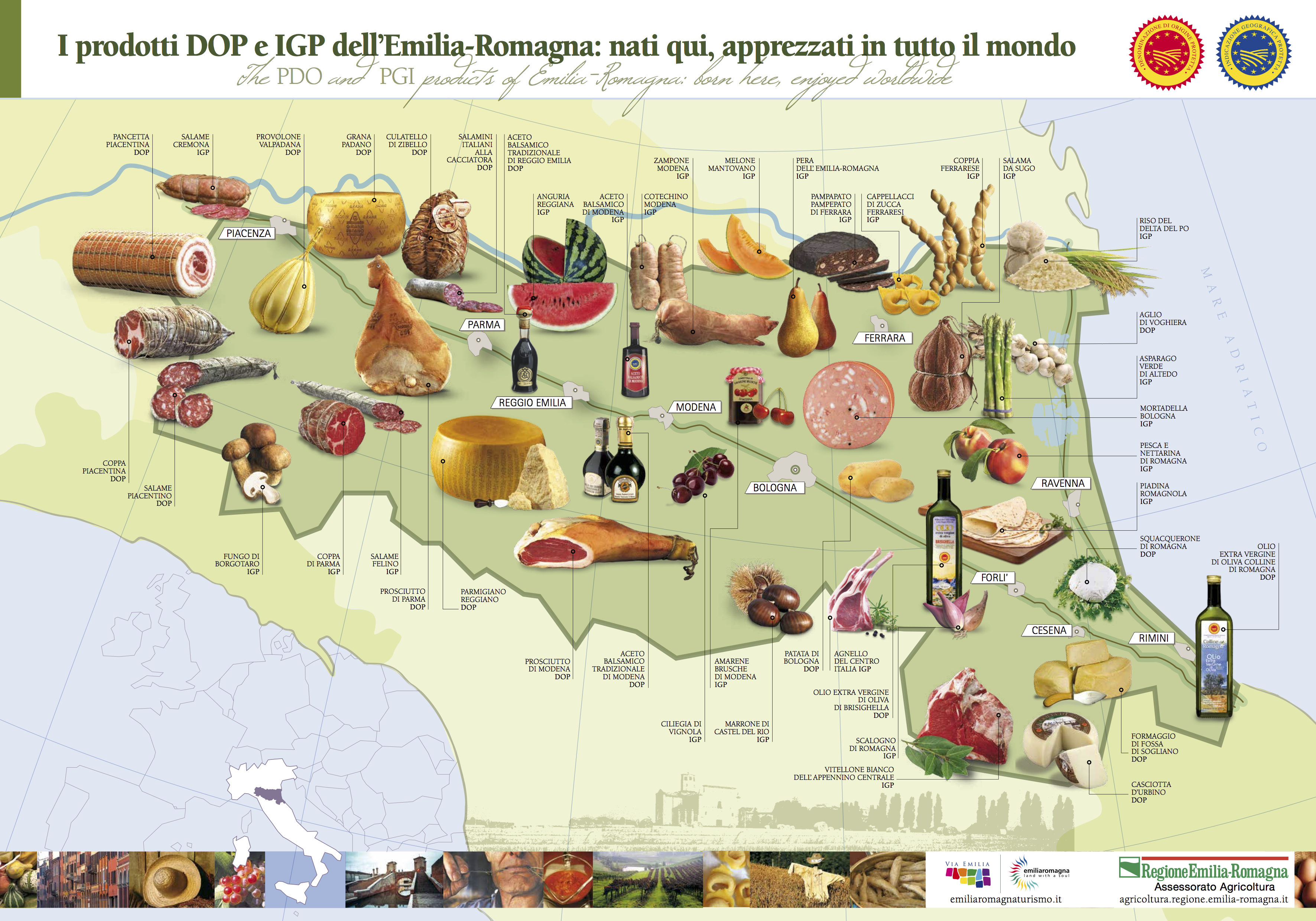Food Valley: the Flavors of Emilia Romagna
A Paradise for Foodies
Emilia Romagna is truly the land of flavors, making it a destination for the gourmand in search of tradition, authenticity and thoughtful processes often dating back to ancient times. The region’s pantry is constantly enriched with new quality products that are recognized by the European Union, confirming Emilia Romagna as having some of the richest and most savored culinary offerings in the world.
To date, Emilia Romagna boasts 44 PDO (Protected Designation of Origin) and PGI (Protected Geographical Indication) products, including the renowned Parmigiano Reggiano, Culatello di Zibello and Aceto Balsamico Tradizionale di Modena (Parmesan cheese, cured pork from Zibello and traditional balsamic vinegar from Modena), in addition to great quality DOC and IGT wines, 15 Slow Food Presidia and more than 200 traditional products registered in the ministerial register.
Emilia Romagna is called the Food Valley because of its world-known culinary traditions, which range from Michelin-rated restaurants to street food like piadina (flatbread). Piadina is offered by over two-thousand kiosks in Romagna, which sell it filled in a million different ways. This food and wine heritage is a total reflection of the region’s culture, so much so that 19 museums have been dedicated to the pleasures of food.
Cooking Classes
Several cooking courses are available for those not simply satisfied with tasting, who would literally like to get their hands in the dough. Standing out among them is a course open to Italians and foreigners offered by Alessandra Spisni’s Vecchia Scuola Bolognese. The Mariette Association at Casa Artusi in Forlimpopoli offers home cooking courses which are closely connected with tradition in Emilia Romagna. This Association was founded in memory of Marietta Sabatini, who was a legendary cook for Pellegrino Artusi. He was a true Romagnolo and is considered to be the first person to have decoded Italian provincial cuisine. Artusi wrote the book “La scienza in cucina e l’arte del mangiar bene” (Science in the Kitchen and the Art of Eating Well), first published in 1891 and followed by 15 additional editions. It is considered the reference text for Italian home cooking.
PDO and PGI Products
With the recent addition of salami sausage Salame Felino PGI, there are now 44 PDO and PGI products made according to local expertise and tradition. Today, Emilia Romagna boasts 19 PDO brands and just as many PGI products. The most well-known PDO products include the three great cheeses Parmigiano Reggiano, Grana Padano and Formaggio di Fossa di Sogliano, which have been joined by Squacquerone di Romagna, but they also include unique cured pork meats such as Prosciutto di Parma, Prosciutto di Modena and Culatello di Zibello – not to mention the exquisite traditional balsamic vinegars from Modena and Reggio Emilia. The region also boasts a fine wine heritage, including 21 DOC wines, the oldest white DOCG wine in Italy and 9 IGT wines, resulting in the production of some 158 million gallons (it produces the most wine in Italy, after the region of Veneto). Emilia Romagna is also home to those rows of Lambrusco wine that the whole world is pointlessly attempting to imitate.
The queen of Street Food
The region’s most famous street food can be enjoyed in the seaside towns along the Riviera: the tasty piadina. There are some 2,000 kiosks along the coast, where foodies can learn about the differences between the piadina riminese (which is thinner and contains less fat) and the thicker piadina romagnola. They are sold at cheerful, customary red-and-white striped (but sometimes green or blue) kiosks. Their traditional shape is reminiscent of the beach huts from long ago. Piadine can be eaten at any time of the day: for lunch or dinner, after a day at the beach or a stroll. There are many types, from the classic one with Parma ham, Squacquerone cheese and rocket salad, to the sweetest one with Nutella spread.
The Pleasures of Food on Display in 19 Museums
19 museums dedicated to some of the most well-known treasures in Emilia Romagna tell their story, explain their complex and fascinating production processes and provide interesting information. It’s an innovative approach to tourism while maintaining and unveiling a region’s culture through its traditional products. Visitors in these temples of flavor are guided by tales, stories, unpublished photos and tasting. They travel on a journey to discover products such as Parmigiano Reggiano, Aceto Balsamico Tradizionale di Modena, Prosciutto di Parma, Salame Felino, Formaggio di Fossa cheese, salt from Cervia, oil from Brisighella, chestnuts from Castel del Rio, eels from Comacchio (which apparently can be cooked in 48 different ways), Tigella (typical local bread), bread from Ferrara, Lambrusco wine, honey, fruit, potatoes and tomatoes.
These special museums also include Casa Artusi in Forlimpopoli, the first food and wine cultural center dedicated to Italian home cooking, and the Enoteca Regionale di Dozza, a true wine library that pays homage to Emilia Romagna’s red and white wines.

